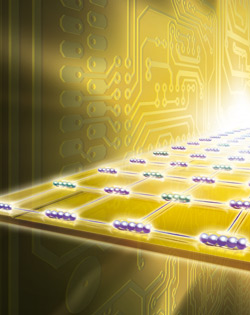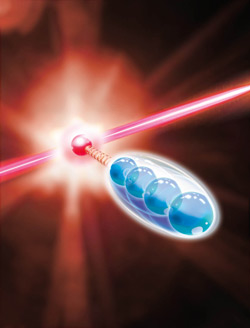Quantum Computer – Tune in Now!
Atomic antennae transmit quantum information across a microchip
The Austrian research group led by physicist Rainer Blatt suggests a fundamentally novel architecture for quantum computation. They have experimentally demonstrated quantum antennae, which enable the exchange of quantum information between two separate memory cells located on a computer chip. This offers new opportunities to build practical quantum computers. The researchers have published their work in the scientific journal Nature.
Six years ago scientists at the University of Innsbruck realized the first quantum byte – a quantum computer with eight entangled quantum particles; a record that still stands. “Nevertheless, to make practical use of a quantum computer that performs calculations, we need a lot more quantum bits,” says Prof. Rainer Blatt, who, with his research team at the Institute for Experimental Physics, created the first quantum byte in an electromagnetic ion trap. “In these traps we cannot string together large numbers of ions and control them simultaneously." To solve this problem, the scientists have started to design a quantum computer based on a system of many small registers, which have to be linked. To achieve this, Innsbruck quantum physicists have now developed a revolutionary approach based on a concept formulated by theoretical physicists Ignacio Cirac and Peter Zoller. In their experiment, the physicists electromagnetically coupled two groups of ions over a distance of about 50 micrometers. Here, the motion of the particles serves as an antenna. “The particles oscillate like electrons in the poles of a TV antenna and thereby generate an electromagnetic field,” explains Blatt. “If one antenna is tuned to the other one, the receiving end picks up the signal of the sender, which results in coupling.” The energy exchange taking place in this process could be the basis for fundamental computing operations of a quantum computer.
Antennae amplify transmission
“We implemented this new concept in a very simple way,” explains Rainer Blatt. In a miniaturized ion trap a double-well potential was created, trapping the calcium ions. The two wells were separated by 54 micrometers. “By applying a voltage to the electrodes of the ion trap, we were able to match the oscillation frequencies of the ions,” says Blatt. “This resulted in a coupling process and an energy exchange, which can be used to transmit quantum information.” A direct coupling of two mechanical oscillations at the quantum level has never been demonstrated before. In addition, the scientists show that the coupling is amplified by using more ions in each well. “These additional ions function as antennae and increase the distance and speed of the transmission,” says Rainer Blatt, who is excited about the new concept. This work constitutes a promising approach for building a fully functioning quantum computer. “The new technology offers the possibility to distribute entanglement. At the same time, we are able to target each memory cell individually,” explains Rainer Blatt. The new quantum computer could be based on a chip with many micro traps, where ions communicate with each other through electromagnetic coupling. This new approach represents an important step towards practical quantum technologies for information processing.
The quantum researchers are supported by the Austrian Science Fund FWF, the European Union, the European Research Council and the Federation of Austrian Industries Tyrol.
Publication: Trapped-ion antennae for the transmission of quantum information. Maximilian Harlander, Regina Lechner, Michael Brownnutt, Rainer Blatt, Wolfgang Hänsel. Advanced online publication Nature 2011 DOI: 10.1038/nature09800
Quantum simulator accessible to the world
Austrian researchers realize a toolbox for open-system quantum simulation
Experimental physicists have put a lot of effort in isolating sensitive measurements from the disruptive influences of the environment. In an international first, Austrian quantum physicists have realized a toolbox of elementary building blocks for an open-system quantum simulator, where a controlled coupling to an environment is used in a beneficial way. This offers novel prospects for studying the behavior of highly complex quantum systems. The researchers have published their work in the scientific journal Nature.
Many phenomena in our world are based on the nature of quantum physics: the structure of atoms and molecules, chemical reactions, material properties, magnetism and possibly also certain biological processes. Since the complexity of phenomena increases exponentially with more quantum particles involved, a detailed study of these complex systems reaches its limits quickly; and conventional computers fail when calculating these problems. To overcome these difficulties, physicists have been developing quantum simulators on various platforms, such as neutral atoms, ions or solid-state systems, which, similar to quantum computers, utilize the particular nature of quantum physics to control this complexity. In a special issue at the end of 2010, the scientific journal Science chose the progress made in this field as one of the scientific breakthroughs of the year 2010.
In another breakthrough in this field, a team of young scientists in the research groups of Rainer Blatt and Peter Zoller at the Institute for Experimental Physics and Theoretical Physics of the University of Innsbruck and the Institute of Quantum Optics and Quantum Information (IQOQI) of the Austrian Academy of Sciences have been the first to engineer a comprehensive toolbox for an open-system quantum computer, which will enable researchers to construct more sophisticated quantum simulators for investigating complex problems in quantum physics.
Using controlled dissipation
The physicists use a natural phenomenon In their experiments that they usually try to minimize as much as possible: environmental disturbances. Such disturbances usually cause information loss in quantum systems and destroy fragile quantum effects such as entanglement or interference. In physics this deleterious process is called dissipation. Innsbruck researchers, led by experimental physicists Julio Barreiro and Philipp Schindler as well as the theorist Markus Müller, have now been first in using dissipation in a quantum simulator with trapped ions in a beneficial way and engineered system-environment coupling experimentally. “We not only control all internal states of the quantum system consisting of up to four ions but also the coupling to the environment,” explains Julio Barreiro. “In our experiment we use an additional ion that interacts with the quantum system and, at the same time, establishes a controlled contact to the environment,“ explains Philipp Schindler. The surprising result is that by using dissipation, the researchers are able to generate and intensify quantum effects, such as entanglement, in the system. “We achieved this by controlling the disruptive environment,“ says an excited Markus Müller.
Putting the quantum world into order
In one of their experiments the researchers demonstrate the control of dissipative dynamics by entangling four ions using the environment ion. “Contrary to other common procedures this also works irrespective of the initial state of each particle,” explains Müller. “Through a collective cooling process, the particles are driven to a common state.“ This procedure can be used to prepare many-body states, which otherwise could only be created and observed in an extremely well isolated quantum system. The beneficial use of an environment allows for the realization of new types of quantum dynamics and the investigation of systems that have scarcely been accessible for experiments until now. In the last few years there has been continuous thinking about how dissipation, instead of suppressing it, could be actively used as a resource for building quantum computers and quantum memories. Innsbruck theoretical and experimental physicists cooperated closely and they have now been the first to successfully implement these dissipative effects in a quantum simulator.
The Innsbruck researchers are supported by the Austrian Science Fund (FWF), the European Commission and the Federation of Austrian Industries Tyrol.
Publication: An Open-System Quantum Simulator with Trapped Ions. Julio T. Barreiro, Markus Müller, Philipp Schindler, Daniel Nigg, Thomas Monz, Michael Chwalla, Markus Hennrich, Christian F. Roos, Peter Zoller und Rainer Blatt. Nature 2011. DOI: 10.1038/nature09801
Rückfragehinweis:
Rainer Blatt
Institute for Experimental Physics
University of Innsbruck
Phone: +43 512 507-6350
Email: rainer.blatt@uibk.ac.at
Christian Roos
Institute for Quantum Optics and Quantum Information (IQOQI)
Phone: +43 512 507-4728
Email: christian.roos@uibk.ac.at
Julio Barreiro
Institute for Experimental Physics
University of Innsbruck
Phone: +43 512 507-6321
Email: julio.barreiro@uibk.ac.at
Christian Flatz
Public Relations
University of Innsbruck
Phone: +43 650 5777122
Email: christian.flatz@uibk.ac.at

